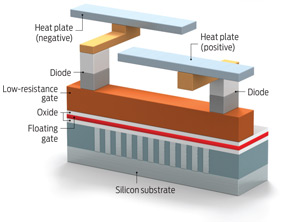Heated flash memory up to 800 ° C

Macronix, a major Taiwanese flash memory manufacturer, has developed technology to extend the life of flash memory chips from the current 10,000 write cycles to at least 100,000,000 write cycles . Macronix engineers say that the lifespan can be more, in the region of 1 billion cycles. To verify this, it takes several months.
The way to extend the life of flash memory is quite trivial, it was discussed earlier, but so far nobody has been able to implement it properly. It is about heating the microcircuits for a few milliseconds to a temperature of 800 ° C.
The degradation of flash memory is associated with the accumulation of residual charge with each rewrite of the cell. After several thousand rewrite cycles, this residual charge increases to such an extent that further use of the cell as a storage medium becomes impossible.
')
Experts have long said that heating to a sufficiently high temperature allows you to get rid of the residual charge. After eliminating the residual charge, the microcircuit began to work "like new." It was assumed that for this purpose it is necessary to heat the microcircuit up to 250 ° C for several hours. Naturally, in real conditions it is impossible to do.
Macronix engineers have found a solution by using the methods of working with phase-change memory (PRAM) - non-volatile memory, in which the information carrier is chalcogenide. When heated, this substance switches between two states: crystalline and amorphous. The substance in the PRAM microcircuit changes its state when heated to 600 ° C for several nanoseconds. Macronix experts decided to check how flash memory cells react to short-term heating to high temperatures. As a result of the experiments, they found a “healing effect” in the region of 800 ° C.
It turns out that it is enough to periodically heat the memory to 800 ° C. Macronix designed a special design memory chip, with miniature heaters. For the new design, we had to modify the traditional flash cell pattern (in the illustration).

Heated cells are rarely required, and you can “fry” one cell at a time, so this procedure will not be too burdensome for a mobile device battery, says Hang-Ting Lue, Macronix deputy director and one of the authors of the scientific work .
Macronix will present the research results at the IEEE International Electron Devices Meeting 2012 , which will be held December 10-12 in San Francisco.
[ Source ]
Source: https://habr.com/ru/post/161125/
All Articles